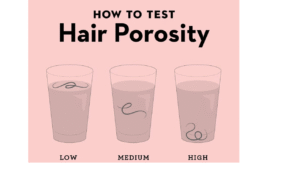When it comes to hair care, one size doesn’t fit all. Different hair types require different methods of care and maintenance. One key factor in understanding your hair is porosity—the ability of your hair to absorb and retain moisture. If you’ve ever noticed your hair gets dry quickly, feels brittle, or struggles to hold a style, you might be dealing with high porosity hair. Let’s dive into what high porosity hair really is, how to take care of it, and how to ensure your locks stay hydrated and healthy.
What is High Porosity Hair?
High porosity hair refers to hair that has gaps or holes in the cuticle (the outermost layer of the hair strand). These gaps allow moisture and other substances to enter and exit the hair shaft quickly. While this might sound like a good thing, the reality is that high porosity hair tends to absorb moisture too easily and then loses it just as quickly.
Understanding the Structure of Hair
Before we dig into the characteristics of high porosity hair, let’s briefly discuss hair structure. Each hair strand is made up of three layers:
-
The cuticle (outer layer) protects the inner layers from damage.
-
The cortex (middle layer) contains the protein (keratin) that gives your hair its strength.
-
The medulla (core) is a hollow space found in some hair types.
In high porosity hair, the cuticle is lifted or raised, creating gaps between the scales of the cuticle. This is often due to damage caused by over-processing, chemical treatments, or even heat styling.
How to Identify High Porosity Hair

Wondering if your hair is high porosity? Here are some key signs:
-
Quickly absorbs water: When you wash your hair, it may feel very wet immediately because it absorbs water fast.
-
Dryness: Despite absorbing moisture quickly, your hair often feels dry or brittle because it loses that moisture just as easily.
-
Frizziness: High porosity hair tends to get frizzy, especially in humid weather, because the cuticle is less sealed.
-
Easily tangled: The gaps in the cuticle can cause hair to catch on itself, leading to tangles or breakage.
-
Difficulty holding styles: High porosity hair might struggle to retain curls or styles, as moisture can escape easily.
Causes of High Porosity Hair
High porosity hair can be a natural trait, but it is often the result of environmental and chemical factors. Here are some common causes:
-
Chemical treatments: Hair dyeing, bleaching, and perming can damage the cuticle, raising it and increasing porosity.
-
Heat styling: Frequent use of flat irons, curling irons, and blow dryers can weaken the hair shaft and lead to high porosity.
-
Sun damage: Extended exposure to the sun can degrade the protective cuticle layer, leaving your hair more porous.
-
Environmental factors: Pollution, hard water, and seasonal changes can affect your hair’s porosity, especially if it’s already prone to damage.
Caring for High Porosity Hair
If you have high porosity hair, don’t worry—you can still keep it healthy and vibrant with the right care. Here are some tips to help you manage and care for your strands:
1. Use Moisturizing Products
Since high porosity hair struggles to retain moisture, using deeply moisturizing shampoos, conditioners, and hair masks is crucial. Look for products that are rich in natural oils (like argon oil, coconut oil, or shear butter) and humectants (like glycerin or honey) that draw moisture into the hair.
2. Avoid Harsh Shampoos
opts for sulfate-free shampoos. Sulfates strip natural oils from your hair, leaving it even more dry and prone to frizz. Stick with gentle, moisturizing cleansers to keep your hair hydrated without over-drying.
3. Deep Condition Regularly
Deep conditioning treatments should be part of your regular hair care routine. Aim to deep condition your hair at least once a week to restore moisture, improve elasticity, and strengthen the hair shaft. Look for protein-rich masks if your hair needs a bit of extra strengthening.
4. Seal in Moisture
After moisturizing, seal your hair with an oil or leave-in conditioner to prevent moisture from escaping. Oils like jojoba, argon, and almond oil can help to lock in hydration and smooth the cuticle, preventing it from raising further.
5. Limit Heat Styling
Try to reduce the amount of heat you apply to your hair. Heat styling can exacerbate the issues caused by high porosity, leading to even more damage. When you do use heat, always apply a heat protectant first to minimize damage.
6. Avoid Over-Washing
Washing your hair too frequently can strip it of its natural oils, leaving it drier. Try to wash your hair no more than 2-3 times a week to allow your natural oils to nourish your hair. On off days, you can refresh your hair with a leave-in conditioner or dry shampoo.
Best Haircare Products for High Porosity Hair

There are several products specifically designed to help with high porosity hair. Look for shampoos, conditioners, and treatments that are aimed at moisture retention, strengthening, and smoothing the hair cuticle. Some top ingredients to look for include:
-
Coconut oil
-
Argan oil
-
Shea butter
-
Glycerin
-
Aloe vera
-
Keratin
These ingredients work together to hydrate, protect, and restore balance to high porosity hair.
Common Mistakes to Avoid with High Porosity Hair
To keep your hair in top shape, here are some common mistakes to avoid:
-
Using products with drying alcohols: These can further dehydrate your hair and exacerbate frizz.
-
Skipping protein treatments: While moisture is important, your hair also needs strength from protein. Balance both moisture and protein for optimal health.
-
Rough towel drying: Avoid aggressively rubbing your hair with a towel, as this can cause more damage to the already fragile cuticle. Instead, gently blot your hair dry or use a microfiber towel.
Conclusion
High porosity hair can be a challenge, but with the right knowledge and care, you can keep it looking healthy, shiny, and manageable. By focusing on moisture retention, using the right products, and minimizing damage, you can restore your hair’s natural beauty and vitality. Remember, consistency is key when it comes to hair care—don’t be discouraged if it takes a bit of time to see results!
FAQs about High Porosity Hair
-
How do I know if my hair is high porosity?
-
You can test your hair’s porosity by performing the “float test.” Simply drop a strand of clean, dry hair into a glass of water. If it sinks quickly, you likely have high porosity hair.
-
-
Can I fix high porosity hair?
-
While you can’t change your hair’s natural porosity, you can manage high porosity hair by using moisturizing and strengthening treatments to restore its health and prevent damage.
-
-
What’s the best oil for high porosity hair?
-
Oils like argan oil, jojoba oil, and castor oil are excellent choices for sealing in moisture and providing nourishment to high porosity hair.
-
-
Is high porosity hair the same as damaged hair?
-
High porosity hair can be a result of damage, but not all high porosity hair is damaged. Some people are born with high porosity hair, while others develop it due to chemical treatments or heat styling.
-
-
Can high porosity hair be straightened?
-
Yes, you can straighten high porosity hair, but make sure to use a heat protectant to minimize further damage and keep your hair from drying out.
-

